
With the geo-political environment in the Indo-Pacific region changing very fast, India and Australia have come together to infuse dynamism in their bilateral defence engagement under the Comprehensive Strategic Partnership. Ongoing defence cooperation between the two countries received further boost when they recently held their first two-plus-two ministerial dialogue, reflecting their commitment to deal with the emerging challenges to regional security effectively and in cooperation with each other.
On September 10, when Rajnath Singh met his Australian counterpart Peter Dutton at his impressive and well maintained office at South Block in New Delhi, the Defence Minister’s comment at the in-person meeting was assertive and emphatic.
He told the visiting Australian Defence Minister that India was looking forward to further strengthening defence ties with Canberra. The Australian Defence Minister sitting opposite his Indian counterpart nodded in agreement that both countries would have to walk hand-in-hand to realize the full potential of their Comprehensive Strategic Partnership.
The Australian Defence Minister, who along with Foreign Minister Marise Payne had visited India for the first two-plus-two ministerial dialogue, was hinting towards advancing defence cooperation between the two countries for their shared security challenges across the Indo-Pacific region.
It would be pertinent to note that defence relationship lies in the core of the India-Australia Comprehensive Strategic Partnership, upgraded by the two countries during the Leaders’ virtual summit held in June 2020.
However, ball started rolling when New Delhi and Canberra signed a historic agreement, called ‘Mutual Logistics Support Agreement’ during the Leaders’ summit in 2020. It envisages reciprocal access to military logistic facilities, joint military exercise and interoperability between armed forces of the two countries. It also envisages reciprocal access to military facilities in terms of logistics support which generally include food, water, fuel, spare parts and other components.
Driven by their common objective to take on challenges thrown by China, the two countries under the rubric of Comprehensive Strategic Partnership have also agreed to expand military engagements across the three services. Currently, their military level engagement is limited to biennial AUSINDEX, a naval exercise which the two countries have been undertaking since 2015. The 2019 event of AUSINDEX was held in the Bay of Bengal. It saw the first anti-submarine warfare exercise and also the first coordinated P-8 maritime patrol aircraft over the Bay of Bengal.
The fourth edition of this bilateral naval exercise between India and Australia was held between September 5 and 13 in northern Australia. It saw Indian Navy warships INS Shivalik and INS Kadmatt training alongside Royal Australian Navy frigate HMAS Warramunga. Both Indian and Australian ships were joined by an Australian submarine, P-8A maritime patrol aircraft, tactical fighter jets and helicopters from both the navies.
In fact, a framework for security cooperation that was established between India and Australia in November 2014, created the base for an enhanced bilateral defence engagement between the two countries. It allowed the two countries to conduct bilateral maritime exercise and explore defence research and development cooperation through visits by Indian and Australian defence delegations and by fostering joint industry links. For the first time, it paved the way for regular Defence Ministers’ meeting, annual Defence Policy talks, service to service engagement including regular high-level visits, annual staff talks and joint training and regular exercises.
The re-establishment of the Quadrilateral Security Dialogue between India, Japan, the US and Australia in 2017 and its successive elevation from the official to the ministerial to finally, the leadership level and then Australia’s participation in the Malabar naval exercise further infused dynamism in the defence cooperation of India and Australia. Invariably, spike in China’s military activities in the Indo-Pacific region and escalation of Beijing’s tension with India and Australia on different planes are factors behind such rapid developments in the defence engagement of the two countries.
Remember, in the Indo-Pacific region, China has increased its aggressive behaviour in the South China Sea. It claims all of the 1.3 million square mile of the Sea as its sovereign territory. It has already built military bases by developing artificial islands in the region, also claimed by the Philippines, Vietnam, Malaysia, Brunei and Taiwan. Lying in the Western Pacific Ocean region, the South China Sea has a multiple strategic importance from resources to location.

Significantly, in terms of resources, it has proven oil reserves of around 7.7 billion barrels, while natural gas reserves are estimated to total around 266 trillion cubic feet. Then, one-third of the world’s trade (over $3 trillion) passes through this sea route each year, making it one of key sea-lanes in the world. Any country that controls this sea route will have natural military advantages, thereby, making the region strategically very important when it comes to controlling the rest of Asia.
China, armed with nuclear submarines, warships, advanced aircraft, bombers and missile systems and physical control over critical islands in the South China Sea, has an upper hand in exerting its authority over the entire region. Already, by using its imaginary claim through the Nine-Dash-Line that stretches hundreds of miles South and East from southerly province of Hainan, China has made it clear to the world that the region belongs to it and it will not brook any challenge over such claim. And this is what worries the world the most.
In 2016, an international tribunal in The Hague found that China’s Nine-Dash-Line claim lacked a legal basis. Four years later, in 2020, Australia and nine other countries, including the US, the UK, France, Germany, the European Union, the Philippines, Vietnam and Malaysia, issued statements rejecting China’s expansionism.
India too has raised its voice against Beijing’s imaginary claim over the South China Sea at several international forums, including the UNSC. Nearly $200 billion worth of India’s trade passes through the South China Sea and thousands of its nationals work, study and invest in the ASEAN countries, Japan, South Korea and also China. India is concerned that if China establishes its un-challenged sway over the Sea, it would hugely impact the flow of trade and commerce, besides damaging its geo-political interests in the region.
Australia, with stakes in peace and security in the region came out with a Defence White Paper in 2016 which arguably drives Canberra’s defence strategy towards the South China Sea. It calls for a secure, resilient Australia, with secure northern approaches and proximate sea lines of communication; a secure nearer region, encompassing maritime Southeast Asia and the South Pacific; and, a stable Indo-Pacific region and a rules-based global order.
In substance, rising China’s militaristic activity in the region has pushed New Delhi and Canberra into a warm and deeper embrace of each other on the defence and strategic front. And, reflection of this bonhomie between the two countries can be unambiguously seen in their joint statement issued after the inaugural two-plus-two ministerial dialogue in New Delhi on September 11.
“India and Australia reiterated the importance of the defence relationship, a core pillar of the Comprehensive Strategic Partnership. India and Australia acknowledged the increased defence cooperation between both countries and discussed initiatives to enhance defence engagements. Both sides welcomed the success of the recently concluded Exercise Malabar Phase I,” read the India-Australia Joint Statement.
Invariably, both India and Australia are keen to impart more vigor and strength to their partnership. Decision of the Indian military to participate in the forthcoming Talisman Sabre exercise, a major Australian and the US military training exercise focused on the planning and conduct of mid-intensity high-end war fighting is a case in point. Besides, in sync with its growing maritime relationship with Canberra, India has allowed the presence of a Liaison Officer from Australia at the Gurgaon-based Information Fusion Centre for Indian Ocean Region.
On the technology front, both countries have shown their keenness to work together in the areas of unmanned vehicles and other niche technologies. Obviously, such developments are not possible in the absence of trust, mutual understanding and common vision for a safe, secure and threat-free world.
–The writer is a senior journalist with wide experience in covering international affairs. The views expressed are of the writer and do not necessarily reflect the views of Raksha Anirveda








